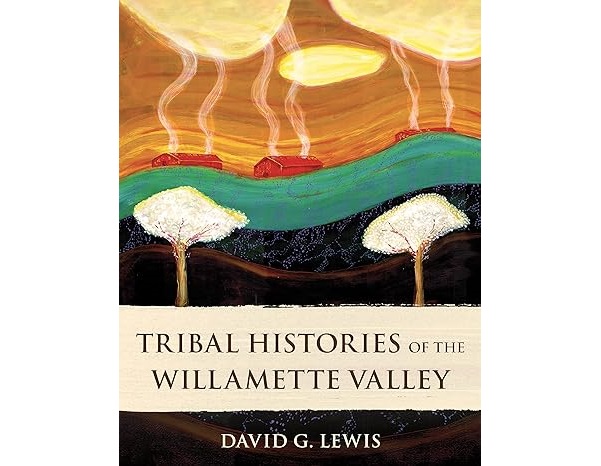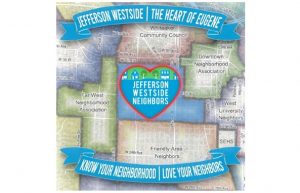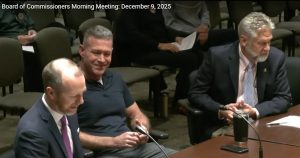Whiteaker shares research after hearing requests to rename neighborhood
9 min read
At the Human Rights Commission Jan. 23, an overview of a report by Dr. David Lewis. From the Whiteaker Community Council:
Stephen Fuller-Rowell (Whiteaker Community Council): In June 2020—this was during the Black Lives Matter protests in June 2020—about 100 people spoke with or were addressing the Whiteaker council asking us to change the name of our neighborhood because the name of the Whiteaker commemorates the first governor of Oregon.
[00:00:32] The Whiteaker Community Council board discussed the request and it was agreed that the Whiteaker board did not know enough about the history of our area to be able to move to proposing a name change or discussing a name change.
[00:00:49] I (possibly unadvisedly) volunteered to do the research and it turned out to be a much bigger project than I had thought. We gradually worked our way back through the history and got to the point where the history was obscured by—what we called in our ‘Street Name Report,’ which was a separate project that the WeCU committee has been doing—obscured by what we called the ‘settler mythology,’ the pioneer tales, that very interestingly conflated Kalapuya people living here and made them almost indistinguishable from people from much further east, the people in the plains.
[00:01:31] And what the 4J (School District) people are doing with their totem poles was very similar to pioneer tales. So it’s disturbing to see this trend of stereotyping local people so that they have more in common with the people way, way much further east from here.
[00:01:50] The land acknowledgement that you do at the beginning of your meeting gives you the broad framework of the time period, and the subsequent history of what Dr. Lewis was addressing in his report to us.
[00:02:06] John Q: That land acknowledgement notes that the Kalapuya people were forcibly moved in the 1850s.
[00:02:14] Scott Lemons (Human Rights Commission, chair): Following treaties between 1851 and 1855, Kalapuya people were dispossessed of their Indigenous homelands by the United States government and forcibly removed to the coastal reservation in Western Oregon.
[00:02:29] Stephen Fuller-Rowell (Whiteaker Community Council): And we were particularly in the Whiteaker Community Council interest in the period from 1846, which incidentally was the year when the U.K. and the USA agreed on where the international border should be. And prior to that, there was a strong possibility that the international boundary could have been the Columbia River. So until 1846, no one knew where the international boundary was going to be between the U.S. and British Canada.
[00:03:00] So 1846 was an interesting year and it was the year that Eugene Skinner arrived here, one of the first white settlers from the east who intended to stay. And he was one of the first of that flood of people arriving in this area.
[00:03:20] The Whiteaker council commissioned this report as part of our research into the history of our area. Until Dec. 2022, Dr. David Lewis was giving us guidance on where to look for information, but we very soon realized that we needed his professional help with doing this research, and we entered into a contract with him in December 2022, and he presented his report to us last November.
[00:03:48] It assembles many of the pieces of the puzzle concerning what was happening at that time and subsequently, which are also very relevant to the history here.
[00:03:59] Dr. Lewis is a professor of anthropology at Oregon State. He’s also a member of the Confederated Tribes of Grand Ronde, where he is an elder. His ancestors are Santiam in the mid-Willamette Valley, Molalla in the Cascade foothills, Takelma down in the Rogue River basin, and Chinook down near the mouth of the Columbia River.
[00:04:24] Several years ago, Dr. Lewis and Yoncalla Kalapuya elder Esther Stutzman (who is one of the authors of the letter that you received a copy of about the totem poles), Dr. Lewis and Esther Stutzman petitioned Lane County several years ago to change the name of the county to Kalapuya County. I don’t know where that petition stands or whether it’s still on the table.
[00:04:50] Recent published work by Dr. Lewis has focused on traditional ecological knowledge (TEK) around the use of fire in forest and open land, and around the importance of wetlands in the hydrology and historical abundance of the Willamette Valley.
[00:05:07] The information we found that is collated in Dr. Lewis’s report of that period, much of this material is like finding a scrapbook of selfies of the so-called pioneers, the so-called settlers. So you’ve got lots of information about Eugene Skinner, lots of information about other people who came from the east.
[00:05:30] And rather like with Google can now look at a picture, look at a selfie, and identify from the background where the picture was taken—it’s kind of scary—then the facial recognition software is now at the point where people in the background and what’s going on the background of a picture can be identified.
[00:05:49] This is very much the process that we needed to find the information about stuff other than the people who were dominating the narrative back at that time.
[00:06:02] Dr. Lewis has confirmed for us that there were essentially four Kalapuya tribal groups here in the Eugene area. There was the Chifin where Eugene is right now, north towards Coburg, and they give their name to the tribal name for our town, Chanchifin, ‘place of the Chifin.’
[00:06:26] The tribal people to the west of us, towards Veneta, the Chelamela, the people to the southeast, down in the Cottage Grove direction, Goshen direction, are the Winefelly.
[00:06:40] There was another group in the Mohawk Valley. We don’t know what the original name for the Mohawk Valley is, but Jacob Spores gave that name to that valley because he thought it looked like the Mohawk Valley in New York State. So the people who lived in that valley tend to be called the Mohawk tribe, even though their name was probably ‘Peyu’ or something like that. And we were unable to establish what those people called themselves.
[00:07:10] What is clear is the time between 1846 and the time that treaties were signed in 1855, during that period, the people coming here from the east were taking land without title, without overall legal authority, so that it’s often referred to as stolen land, and that’s not so inappropriate.
[00:07:38] People who came here misunderstood the kind of agriculture that was done here. They saw a land that was being tended, but it wasn’t being plowed, so they didn’t realize this was land that was cared for.
[00:07:52] It was also, subsequently, those arriving later, saw a land that had been impacted by disease. Diseases brought by European settlers in this area and travelers was responsible for 90%-95% mortality rates in the Willamette Valley.
[00:08:14] However, that happened somewhat later in our area, because when Eugene Skinner is writing to his sister, he refers to ‘lots of people around in the area,’ and he talks about the country being ‘full of Indians,’ he called them, but it was not so heavily depopulated here.
[00:08:36] One of the unknowns, that we were not able to get to the root of, is what caused the drop in population from 1846 to 1855, when people were moved to the Grand Ronde. And Dr. Lewis wonders if this was a late epidemic of malaria, which had affected the Willamette Valley further north at earlier dates. So this area was depopulated a little bit later than the area further north of us.
[00:09:07] Eugene Skinner said, ‘Sometimes there would be 100 Indians at our house.’ So 100 people are in the area, definitely, which is quite a dense population here in 1846-47, but the numbers moved to the Grand Ronde in 1855 were way less, so definitely depopulation.
[00:09:31] The remaining unknowns: We don’t know what exactly was the communication between local Kalapuya people and Eugene Skinner. The stories and the plaques at the bottom of the Skinner Butte say he was told to build further up, and apparently he was told ‘Ya-Po-Ah,’ and that’s the name given to the senior housing development on the other side of Skinner Butte.
[00:09:54] The linguists at the Grand Ronde have looked into that, those words ‘ya-po-ah,’ and nobody knows what that actually meant in Kalapuya, so we’re still researching this. Clearly, there was impact on the land, and clearly there was communication taking place.
[00:10:17] Dr. Lewis has found other examples where local people are giving advice to the settlers about where to build and where not to build and where you can expect it to flood. So the land use patterns in our area were benefited from advice given by local Kalapuya people to the European settlers arriving there.
[00:10:40] We still don’t know what actually happened on Spencer Butte. There’s lots of mythology around Spencer Butte, and it’s the only suggestion that any life was lost in violent conflict in the Eugene area, and there’s definitely doubts on the stories around Spencer Butte. So it’s quite possible that life that was lost around here was due to disease, which was probably made worse by the trauma of the disruption of lifeways in the area, is my guess.
[00:11:15] And as mentioned, we still don’t know really what caused the dramatic population loss between 1846 and 1855. The new knowledge that has come out of the study is that, as I mentioned, the Indigenous knowledge of the topography of the area and the assistance that this gave to people selecting home sites when they came from the east.
[00:11:43] Other settlers described Eugene as Skinner’s Mudhole. I’m not sure that we should change the name of the town to Skinner’s Mudhole, but maybe Chanchifin would be appropriate.
[00:11:55] What Dr. Lewis hadn’t or not many people hadn’t realized: the extent of the cultural activities in the camps around the city when people were not allowed to stay in town after sunset.
[00:12:11] There’s quite active communities in these camps, particularly seasonally when people came here for the fish harvest from the Willamette River in the fall and for hop picking. And that’s the new knowledge that has come out of this.
[00:12:27] And I would welcome any Q&A at some future meeting of the commission to dig into topics that are more of the focus of particular commissioners.
[00:12:41] Blake Burrell (Human Rights Commission): I’m thinking about future directions of this work because I really like to see reports meet the public eye. There may be opportunities in which we could highlight some of this work. Could we facilitate a public event for a public presentation in a genre such as the Eugene Public Library, in which we could give Stephen a full hour and time for Q& A and any researchers involved in this to provide a public presentation endorsed by the commission?
[00:13:08] And then (2), I’d love to see ways that we can take this research and support work plan items that we have to make sure that this is turned into action.
[00:13:22] Stephen Fuller-Rowell (Whiteaker Community Council): Dr. Lewis is working with the Lane County History Museum, and there will probably be an exhibit on this material at Lane County History Museum, rather like the exhibit that was previously done about Black Eugene people. And so that is probably going to come up later in the year, this summer they had previously said.
Dr. Lewis says also that this material is being incorporated or will at some point be incorporated into DEI (Diversity, Equity, Inclusion) training within the city and city agencies. We’re also looking around and also there will be signage for some of this information around the county and the city.
[00:14:05] And I have received suggestions from people that we find a graphic historical novel artist, preferably a enrolled tribal member, who can take this material and make it accessible to a wider demographic. So there are ongoing efforts to make this information more widely available.
[00:14:25] John Q: The Whiteaker Community Council shares research from Dr. David Lewis on local place names. Eugene’s Human Rights Commission hopes to share that report throughout the city.
Dr. David Lewis is author of Tribal Histories of the Willamette Valley, published by Ooligan Press.



